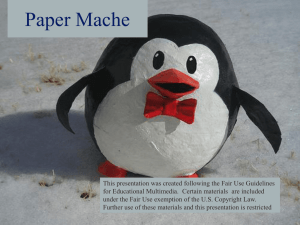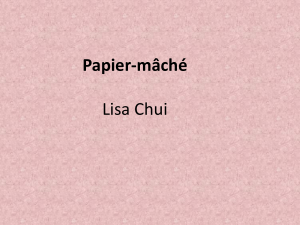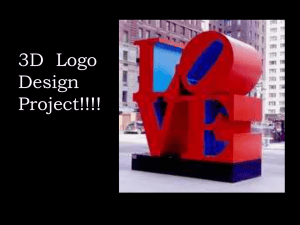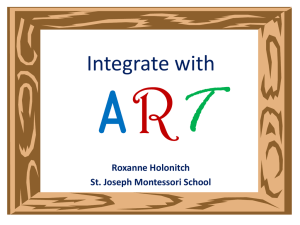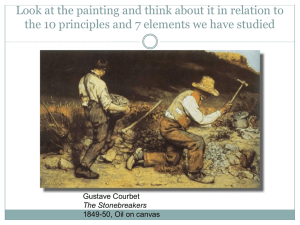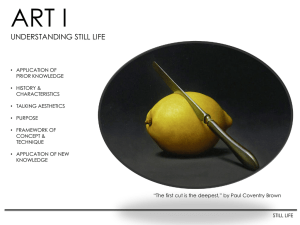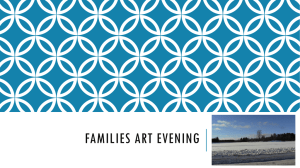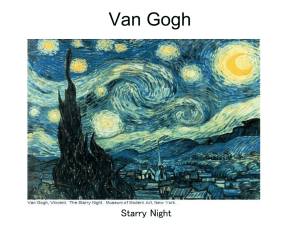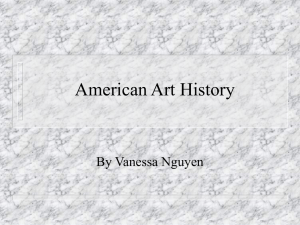Paper Mache : The art of using paper to create objects
advertisement
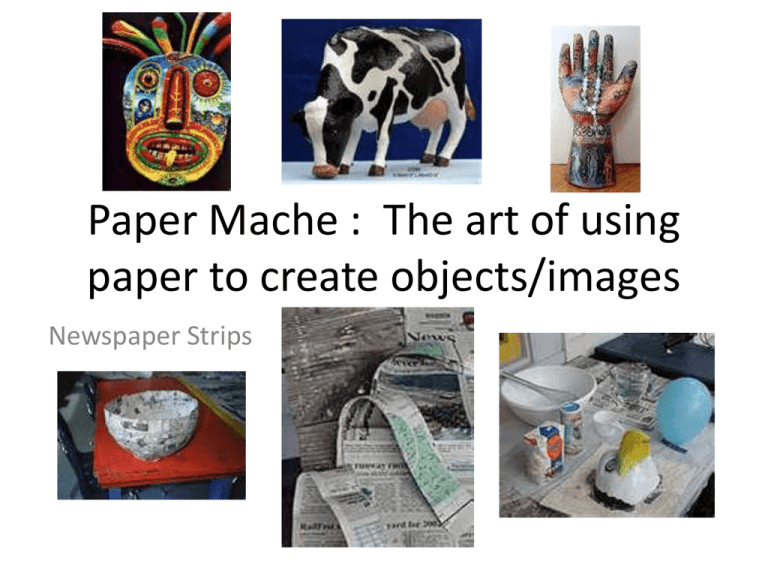
Paper Mache : The art of using paper to create objects/images Newspaper Strips PAPER MACHE: The Art of Paper Made Objects: Paper is ‘molded’ or “formed’. Terms: Papier-Mache, Paper-mache, Carton-pierre, Decoupage, Lacquer, Armature. Please note that most of these terms originated in the French language. Papier-mâché (French for 'chewed-up paper' because of its appearance), sometimes called paper-mâché, is a construction material that consists of pieces of paper, sometimes reinforced with textiles, stuck together using a wet paste (e.g., glue, starch, or wallpaper adhesive). The crafted object becomes solid when the paste dries.[1] Countries where we find paper-mache used as an artistic medium: Persia, Kashmir, Japan, China, England, Russia, India, Korea, America, Italy, France, Germany, Poland, and France. Paper Mache Animals are popular as masks, piggy banks, and as piñatas. Paper mache items can be used for home décor (these won’t spoil like the real fruit) This papier-mâché lacquered bowl could be used to hold the papier-mâché fruit! Aesthetically Pleasing Work Paper Mache is useful for home design/décor. We can make FUNCTIONAL or AESTHETICALLY PLEASING pieces. Papier-mâché was used for doll heads starting as far back as 1540, and continued to be used into the early 20th century. The heads were molded in two parts from a mixture of paper pulp, clay, and plaster, and then glued together. The head would then be smoothed, painted and varnished. Paper Mache has been used to create DOLL HEADS in many different countries. This has gone out of use with the development of modern plastic materials. Papier-mâché is commonly used for large, temporary sculpture such as Carnival floats. A basic structure of wood, metal and metal wire is covered in papier-mâché. Once dried, details are added. The papiermâché is then sanded and painted. Carnival floats can be very large and comprise a number of characters, props and scenic elements all organized around a chosen theme. They can also accommodate several dozens people, including the operators of the mechanisms. The floats can have movable parts, like the facial features of a character or its limbs. It is not unusual for local professional architects, engineers, painters, sculptors and ceramists to take part in the design and construction of the floats. Italian float makers are some of the best in the world, Papier-mâché MASKS and theatrical head gear are important to the world of play-acting Paper Mache has been used to create FLOAT DESIGNS for parades. Papier-mâché has been used in Theatre for creating Set Design objects and Costume Parts Puppetry involves the creation of Papier-mâché Puppets and other associated set pieces. AMAZINGLY: Paper Mache has been used to create ARCHITECTURAL FEATURES such as CELING DESIGNS.. … WALL DESIGNS…..EVEN FURNITURE! RUSSIAN PAPER MACHE WORK: Decorated Boxes The village of Fedoskino (Федоскино)[ located not far from Moscow on the banks of the Ucha River, is the oldest of the four art centers of Russian lacquer miniature painting on papier-mâché, which has been practiced there since 1795. It stands apart both geographically, and in that that oil paints are used rather than egg tempera. The lacquer artists of Palekh, Kholui and Mstera continue to use the technique of painting in egg-based tempera overlaid with intricate gold leaf highlighting. A Palekh jewelery box No Russian lacquer artwork is presently considered genuine piece unless it bears the signature of one of the recognised artists from one of four villages, each village having its own style. Many Countries have used paper Mache to create beautiful objects. To the LEFT are Russian Enameled paper Mache Boxes. Below are items from Asia. FUNCTIONAL OBJECTS can be made out of paper mache. Carton-pierre (French for 'stone cardboard') is papier-mâché that has been decorated to resemble wood, stone, or metal, and is used as decoration.[2] Starting around 1725, gilded papier-mâché began to appear in Europe as a low-cost alternative to similarly treated plaster or carved wood in architecture. Henry Clay of Birmingham, England, patented a process for treating laminated sheets of paper with linseed oil to produce waterproof panels in 1772. Japanned is most often a heavy black lacquer, almost like enamel paint. The European technique uses varnishes that have a resin base similar to shellac, applied in heatdried layers which are then polished, to give a smooth glossy finish. It can also come in reds, greens and blues. Originating in India, China, and Japan as a decorative coating for pottery, it made its way into Europe by the 1600s. Hanji (Korean paper art) Hanji is the name of a traditional paper art form originating from Korea. There are two basic divisions of hanji, a two dimensional and a three dimensional. Two dimensional hanji uses paper of various colors to create an image in a similar format as a painting, however the paper itself is folded and crumpled making the image stick up from the paper it is adhered, but the image itself is only a 2 dimensional likeness, although there may be depth to some of the elements. 2 dimensional hanji are typically framed much like a painting. Korean Hanji 3Dimensional Sculpture Korean Hanji lacquer Boxes Three dimensional Hanji is similar to papier-mâché, in that it attempts to make sculpture type objects which may stand unsupported. More SCULTPURES: Note the stylized forms versus completely realistic forms. ARTISTS use paper mache to create interesting SCULPTURES Skulls are a popular item for artistic designs within the country of Mexico. Artists from around now design skulls. Skulls have been used by many artists for ‘DESIGN’ work…these are papier-mâché skull masks. Home In Art I at Charlottesville High School, all students create paper mache masks. Get ready to get your hands dirty, be creative and have fun!
